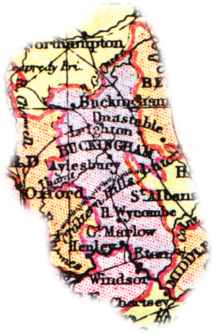Buckinghamshire
Buckinghamshire (abbreviated Bucks) is a ceremonial county in South East England. It borders Greater London to the south-east, Berkshire to the south, Oxfordshire to the west, Northamptonshire to the north, Bedfordshire to the north-east, and Hertfordshire to the east. The county town is Aylesbury, and the largest town is Milton Keynes.
History[edit | edit source]
Buckinghamshire has a rich history dating back to the Anglo-Saxon period. The name is derived from the Anglo-Saxon leader Bucca and the Old English word "scir," meaning district. The county has been significant throughout English history, particularly during the English Civil War and the Industrial Revolution.
Geography[edit | edit source]
The county is characterized by its diverse landscape, which includes the Chiltern Hills, a designated Area of Outstanding Natural Beauty, and the Vale of Aylesbury. The River Thames forms part of the southern boundary of the county.
Economy[edit | edit source]
Buckinghamshire has a mixed economy with a strong emphasis on the service sector, particularly in the towns of High Wycombe, Aylesbury, and Milton Keynes. The county is also known for its agriculture, particularly in the Vale of Aylesbury.
Transport[edit | edit source]
The county is well-connected by road and rail. Major roads include the M40, M1, and A41. Rail services are provided by the West Coast Main Line, Chiltern Main Line, and the East West Rail project, which aims to improve connectivity between Oxford and Cambridge.
Education[edit | edit source]
Buckinghamshire is home to several notable educational institutions, including Buckinghamshire New University and the University of Buckingham. The county also has a number of highly regarded grammar schools, such as Dr Challoner's Grammar School and Royal Grammar School, High Wycombe.
Culture and Landmarks[edit | edit source]
The county boasts numerous cultural and historical landmarks, including:
Notable People[edit | edit source]
Buckinghamshire has been home to many notable figures, including:
- John Milton, the poet
- Benjamin Disraeli, the former Prime Minister
- Roald Dahl, the author
Politics[edit | edit source]
The county is divided into several parliamentary constituencies, including Aylesbury, Buckingham, and Wycombe. The local government is administered by Buckinghamshire Council and Milton Keynes City Council.
Sports[edit | edit source]
Buckinghamshire has a strong sporting tradition, with facilities for football, rugby, cricket, and rowing. The county is home to the Wycombe Wanderers F.C. and the Milton Keynes Dons F.C..
See Also[edit | edit source]
- List of places in Buckinghamshire
- History of Buckinghamshire
- Geography of Buckinghamshire
- Economy of Buckinghamshire
- Transport in Buckinghamshire
- Education in Buckinghamshire
- Culture of Buckinghamshire
- Politics of Buckinghamshire
- Sports in Buckinghamshire
References[edit | edit source]
External Links[edit | edit source]
Search WikiMD
Ad.Tired of being Overweight? Try W8MD's NYC physician weight loss.
Semaglutide (Ozempic / Wegovy and Tirzepatide (Mounjaro / Zepbound) available. Call 718 946 5500.
Advertise on WikiMD
|
WikiMD's Wellness Encyclopedia |
| Let Food Be Thy Medicine Medicine Thy Food - Hippocrates |
Translate this page: - East Asian
中文,
日本,
한국어,
South Asian
हिन्दी,
தமிழ்,
తెలుగు,
Urdu,
ಕನ್ನಡ,
Southeast Asian
Indonesian,
Vietnamese,
Thai,
မြန်မာဘာသာ,
বাংলা
European
español,
Deutsch,
français,
Greek,
português do Brasil,
polski,
română,
русский,
Nederlands,
norsk,
svenska,
suomi,
Italian
Middle Eastern & African
عربى,
Turkish,
Persian,
Hebrew,
Afrikaans,
isiZulu,
Kiswahili,
Other
Bulgarian,
Hungarian,
Czech,
Swedish,
മലയാളം,
मराठी,
ਪੰਜਾਬੀ,
ગુજરાતી,
Portuguese,
Ukrainian
Medical Disclaimer: WikiMD is not a substitute for professional medical advice. The information on WikiMD is provided as an information resource only, may be incorrect, outdated or misleading, and is not to be used or relied on for any diagnostic or treatment purposes. Please consult your health care provider before making any healthcare decisions or for guidance about a specific medical condition. WikiMD expressly disclaims responsibility, and shall have no liability, for any damages, loss, injury, or liability whatsoever suffered as a result of your reliance on the information contained in this site. By visiting this site you agree to the foregoing terms and conditions, which may from time to time be changed or supplemented by WikiMD. If you do not agree to the foregoing terms and conditions, you should not enter or use this site. See full disclaimer.
Credits:Most images are courtesy of Wikimedia commons, and templates, categories Wikipedia, licensed under CC BY SA or similar.
Contributors: Prab R. Tumpati, MD





